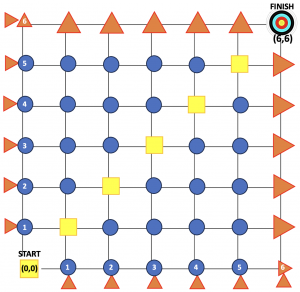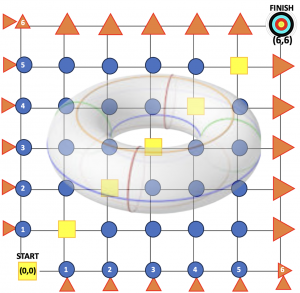Vectors Game
You will need two dice, a counter for each player (or each team) and the gameboard. This is a game for up to 4 players when the players throw the dice for themselves, or for 2 teams, when the leader throws the dice and moves the counters on the board.
 Rules: Players start at (0 , 0). They take turns to throw 2 dice and move their counter from one lattice point to another, choosing one of the numbers for the number of steps across from left to right, and the other number for the number of steps up. If the move would take the counter over the right-hand edge or over the top, it re-enters the board on the left or at the bottom. If it lands on a point occupied by another player, that player starts again from (0 , 0).
Rules: Players start at (0 , 0). They take turns to throw 2 dice and move their counter from one lattice point to another, choosing one of the numbers for the number of steps across from left to right, and the other number for the number of steps up. If the move would take the counter over the right-hand edge or over the top, it re-enters the board on the left or at the bottom. If it lands on a point occupied by another player, that player starts again from (0 , 0).
How to win: The first player to land on (6, 6) wins the round and scores a point. The first player to score 3 points is the winner.
 Carry out a thought experiment! Imagine the moves as vectors, each vector with a horizontal and vertical component. Imagine playing the game on a torus with the 2 directions around the torus: one as shown by the blue and orange circles equivalent to ‘across’ and the other as red and green circles equivalent to ‘up’.
Carry out a thought experiment! Imagine the moves as vectors, each vector with a horizontal and vertical component. Imagine playing the game on a torus with the 2 directions around the torus: one as shown by the blue and orange circles equivalent to ‘across’ and the other as red and green circles equivalent to ‘up’.
Variations: Try the game with each player having 2 counters. When they land a counter on (6, 6) they score a point. Round 1 ends when one player has landed both counters on (6, 6). The winner of the game is the first player to score a total of 3 points.
Please add comments below if you try out this game. It is a new invention by Alan and Toni Beardon, published for the first time here. The game will appear in a new AIMSSEC book to be published by Tarquin Press in March 2024.
Notes for Teachers and an Inclusion and Home Learning Guide will appear here soon. Watch this space?
Click here to download the gameboard and rules.
South Africa COVID-19 News
Here is the official website for COVID-19 updates.
Login
SUPPORT AIMSSEC





